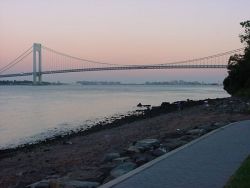Alice Austen Park
Alice Austen House and Park
What was here before?
Before the arrival of Europeans and enslaved people, the Lenape lived on the land that would eventually be called Staten Island. Between 100 and 1,000 individuals from the Algonquian or Delaware tribes lived across the island.
How did this site become a historic house?
The original Dutch farmhouse built in 1690, was purchased in 1844 by Alice Austen's grandfather, John Haggerty Austen. It was named Clear Comfort for the view and fresh air by Alice's grandmother. Austen's architectural transformation of his home from a simple Dutch farmhouse into a Victorian Gothic cottage was extensive. On the roof, he added dormer windows embellished with Victorian bargeboards and birdhouse finials. Decorative cresting and octagonal chimney pots added to the picturesque silhouette. Located at the entrance to New York Harbor, the Alice Austen House stands today as a reminder of the picturesque suburban "cottages" that dotted the shore and hills of 19th-century Staten Island.
In the 1960s, realizing the likelihood that high-rise apartment buildings might replace the Victorian cottage, a group of concerned citizens mounted a serious effort to save the house and grounds. Restoration was completed in April 1985. In 1970, the Alice Austen House was included in the National Register of Historic Places and was designated a New York City Landmark in 1971 and a National Historic Landmark in 1993. In June of 2017, the Alice Austen House amended its national designation to become a site of LGBTQ history.
The Alice Austen House fosters creative expression, explores personal identity, and educates and inspires the public through the interpretation of the photographs, life and historic home of lesbian photographer, Alice Austen (1866-1952).
Who is this historic house named for?
Alice Austen was introduced to photography at age 10 in 1876. In this home’s studio, which was also one of her photographic muses, she produced over 7,000 photographs of a rapidly changing New York City, making significant contributions to photographic history, documenting New York’s immigrant populations, Victorian women’s social activities, and the natural and architectural world of her travels.
One of America’s first female photographers to work outside of the studio, Austen often transported up to 50 pounds of photographic equipment on her bicycle to capture her world. Her photographs represent street and private life through the lens of a lesbian woman whose life spanned from 1866 to 1952. Austen was a rebel who broke away from the constraints of her Victorian environment and forged an independent life that broke boundaries of acceptable female behavior and social rules.
Austen’s photographs provide rare documentation of intimate relationships between Victorian women. Her non-traditional lifestyle and that of her friends’, although intended for private viewing, is the subject of some of her most critically-acclaimed photographs. Austen would spend 53 years in a devoted loving relationship with Gertrude Tate. They spent 30 years living together in this home, which is now the site of the Alice Austen House Museum and a nationally-designated site of LGBTQ history.
Austen’s wealth was lost in the stock market crash of 1929 and she and Tate were evicted from their beloved home in 1945. Tate and Austen were finally separated by the family’s rejection of their relationship and poverty. Austen was moved to the Staten Island Farm Colony where Tate would visit her weekly. In 1951, Austen’s photographs were rediscovered by historian Oliver Jensen, who raised funds from their publication to place Austen in private nursing home care. On June 9, 1952, Austen passed away. The final wishes of Austen and Tate to be buried together were denied by their families.
Today changing exhibitions, archival materials and period rooms at the house sustain the life and legacy of a remarkable woman. The bulk of Austen’s photographic collection is housed at the Staten Island Historical Society at Historic Richmond Town.
Check out your park's Vital Signs
Clean & Safe
Green & Resilient
Empowered & Engaged Users
Share your feedback or learn more about how this park is part of a
Vital Park System




